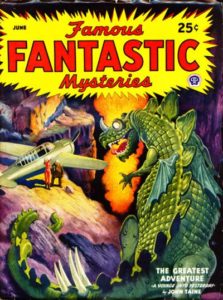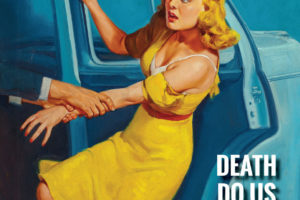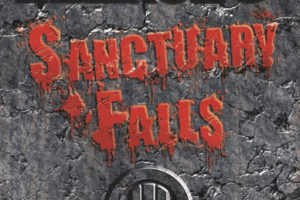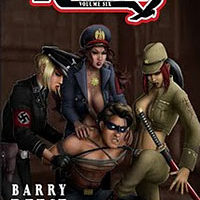 After reading John Taine‘s The Purple Sapphire, an interesting lost-world story, I was interested in reading more of his works.
After reading John Taine‘s The Purple Sapphire, an interesting lost-world story, I was interested in reading more of his works.
Taine, who was really mathematician Eric Temple Bell (1883-1960) and wrote science fiction on the side, had several other novels. A couple have also been reprinted by Armchair Fiction, including The Greatest Adventure.
Like The Purple Sapphire, The Greatest Adventure first appeared in book form in 1929 and was later reprinted and cover featured in Famous Fantastic Mysteries (June 1944). Ace reprinted it in 1960, and Chaosium included it in their collection of works set in Antarctica.
Armchair reprinted it with the cover from the Ace paperback rather than the cover from FFM. Guess they thought it too cartoonish. Would have liked to have seen the interior artwork from FFM.
In this story, we are introduced to Dr. Eric Lane and his daughter, Edith. Lane had made his fortune in China, then used his wealth to educate himself for his life’s goal of understanding the secrets of life. He’s now widowed, and his daughter is a bit of a tomgirl and will be a companying him on this adventure, even learning how to fly.
Living in California, he asks for various bizarre lifeforms found by seamen and fisherman. A third individual is John Drake, a possible love interest for Edith, who is a brilliant man in the area of ancient inscriptions, but has no business sense.
Then one day, a sea captain, Capt. Anderson, brings him the preserved carcass of a baby dinosaur! Or, of something that seemed a missing link between dinosaurs and birds. Something he had found which was still alive in the South Polar seas. And Lane promises to pay him a good sum if he takes Lane and party to this location.
Anderson tells the full tale, with photos taken by his mate Ole Hansen, of eruptions and volcanic activity in Antarctica. And the photos are of pictograms from rocks blown out by the volcano, hence the inclusion of Drake. Ole is a right character, always with weird theories. The five make an interesting group.
At first glance, I figured it would be the standard findings a lost world in Antarctic, heated by volcanoes, with dinosaurs and other prehistoric life, and maybe primitive men who created the pictograms. But instead, it’s an underground world with strange beasts and a secret that theatens the world. And who created those pictograms, and what do they mean?
Also, this work is the first in a loose thematic series around the idea of rapid and uncontrolled evolution. This includes The Iron Star (1930), which has apes that used to be human but (de)evolved after a giant meteorite fell in the Congo; The Crystal Horde (in Amazing Stories Quarterly in 1930 as “White Lily” and reprinted by Armchair Fiction), which has crystalline silicate life threatening to engulf carbon life on Earth; and Seeds of Life (in Amazing Stories Quarterly 1931), with a mad scientist protagonist who decides to exterminate human life.
Overall it’s a good adventure story. Armchair Fiction has reprinted a couple of other Taine works I hope to check out. There are some others I hope someone reprints, including the ones above and others such as Gold Tooth, which is another early lost-world tale.




Your comments